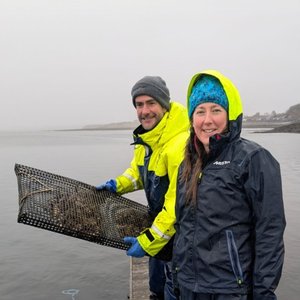Abstract
Abalone are a very high value shellfish with prices of up 70€/kg commonplace. The Irish abalone industry has been slow to develop but in more recent years with the successful establishment of a number of commercial hatcheries around the south and west coasts, in addition to developments in land-based recirculation technologies.
There has been increased interest and investment in this sector. At the time of publishing there were four hatchery/production units and two ongrowing units. Most of the emphasis now in Ireland, is on the growout to market size being undertaken in land based recirculation
Unlike previous methods carried out at sea these technologies allow for accurate control over the environmental conditions being experienced by the abalone. In particular the ability to control temperature should considerably reduce the time taken to reach market size.
Keywords
Abalone, abalone hatchery, manual
Table of contents
Acknowledgements
Contents page
Chapter 1 Introduction
1.1. Background
1.2. General biology of the abalone
1.3. Principal abalone species of the world
Chapter 2 Conditioning of broodstock
2.1. Introduction
2.1.1. Gonad index
2.1.2. Visual or external gonad index
2.1.3. Effective accumulative temperature
2.2. Selection of broodstock
2.3. The conditioning unit
2.3.1. A basic conditioning unit
2.3.2. Flow through conditioning unit
2.3.3. Recirculating conditioning units
2.4. Water quality parameters
2.5. General conditioning considerations
Chapter 3 Spawning
3.1. Introduction
3.2. The hydrogen peroxide spawning method
3.3. Ultraviolet light spawning method
Chapter 4 Larval development and larval culture
4.1. Larval development
4.2. Larval rearing
4.2.1. Use of hatchout trays during larviculture
Chapter 5 Settlement
5.1. Introduction
5.2. Settlement induction
5.2.1. Diatoms
5.2.2. Mucous
5.2.3. GABA
5.3. Metamorphosis
5.4. The role of benthic diatoms in settlement and juvenile nutrition
5.5. Preparation of larval settlement tanks
5.5.1. Protocol for benthic diatom coating production in greenhouse settlement tanks
5.5.2. Transfer of larvae from hatchery to settlement tanks
Chapter 6 Culture of benthic diatoms
6.1. Introduction
6.2. Establishing routine stock cultures
6.3. Upscaling benthic diatom cultures
6.4. Maintenance of biofilms
6.5. Ulvella lens
6.6. Culture of Ulvella lens
6.7. The role of diatoms and Ulvella lens in abalone nursery culture
6.8. Recommendations
Chapter 7 Management of juvenile abalone during the early nursery phase
7.1. Introduction
7.2. Estimation of settlement success
7.3. Monitoring of benthic diatom film
Chapter 8 Protocol for conditioning, spawning, larval rearing and settlement
8.1. Introduction
8.2. Conditioning
8.3. Spawning
8.4. Preparation of settlement tanks
Chapter 9 Weaning stages
9.1. Introduction
9.2. Weaning tank design
9.3. Feeding artificial food
9.4. Handling of abalone spat
9.4.1. Benzocaine
9.4.2. Magnesium sulphate
9.4.3. Carbon Dioxide
9.4.4. Other anaesthetics
9.5. Grading spat
9.6. Culling
9.7. Transporting juvenile abalone
Chapter 10 General conclusions
References used and suggested reading material
Author(s)
By Paul Leighton
Edited By: Geoff Robinson, Niamh McGowan
Aquaculture Technical Section, Aquaculture Development Division, Dublin, Ireland
Publication
Aquaculture Explained, no. 25, November 2008
Bord Iascaigh Mhara
Irish Sea Fisheries Board
Link
Click on the link below:







